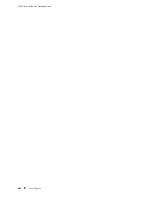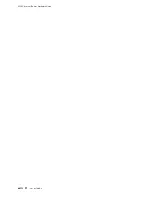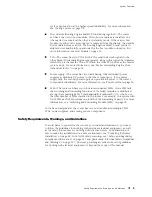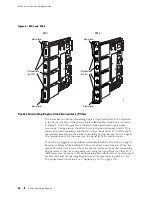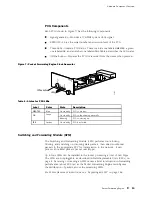
System Overview
system can function at the higher speed indefinitely. For more information,
see Cooling System on page 39.
Host module (Routing Engine and MCS functioning together)—The router
can have one or two host modules. If two host modules are installed, one
(the master) is active and the other is in standby mode. If the master host
module (or either of its components) is removed from the chassis, the standby
host module becomes active. The Routing Engine and MCS must reside in
adjacent slots and be fully operational for the host module to function. For
more information, see Host Module on page 22.
PCG—The router has two PCGs. Both PCGs send their clock signals to the
other Packet Forwarding Engine components, along with a signal that indicates
which clock is the master. If one PCG fails, the other PCG becomes the master
system clock. For more information, see “Packet Forwarding Engine Clock
Generators (PCGs)” on page 18.
Power supply—The router has two load-sharing, fully redundant power
supplies to distribute DC power to the other components. If one power
supply fails, the second power supply can provide full power to the router’s
components indefinitely. For more information, see Power System on page 35.
SFM—The router can have up to four interconnected SFMs. If one SFM fails,
the switching and forwarding functions of the failed module are distributed
among the remaining SFMs. Total bandwidth is reduced by 1/
n
, where
n
is
the total number of SFMs installed in the router. For example, in a system with
four SFMs, each SFM provides one-fourth of the forwarding capacity. For more
information, see “Switching and Forwarding Module (SFM)” on page 19.
In the base configuration, the router has one host module and multiple SFMs,
PCGs, power supplies, and cooling system components.
Safety Requirements, Warnings, and Guidelines
To avoid harm to yourself or the router as you install and maintain it, you need
to follow the guidelines for working with and near electrical equipment, as well
as the safety procedures for working with Internet routers. For a discussion of
how to make the installation site a safe environment, see “Preparing for Router
Installation” on page 59. For a list of safety warnings, see “Safety and Regulatory
Compliance Information” on page 221 and particularly “Electrical Safety Guidelines
and Warnings” on page 227. However, providing an exhaustive set of guidelines
for working with electrical equipment is beyond the scope of this manual.
Safety Requirements, Warnings, and Guidelines
5
Summary of Contents for Internet Router M160
Page 12: ...M160 Internet Router Hardware Guide xii Table of Contents ...
Page 16: ...M160 Internet Router Hardware Guide xvi List of Figures ...
Page 18: ...M160 Internet Router Hardware Guide xviii List of Tables ...
Page 24: ...M160 Internet Router Hardware Guide xxiv Requesting Support ...
Page 26: ...2 Product Overview ...
Page 30: ...M160 Internet Router Hardware Guide 6 Safety Requirements Warnings and Guidelines ...
Page 66: ...M160 Internet Router Hardware Guide 42 Cable Management System ...
Page 80: ...M160 Internet Router Hardware Guide 56 Routing Engine Architecture ...
Page 82: ...58 Initial Installation ...
Page 104: ...M160 Internet Router Hardware Guide 80 Unpacking the Router ...
Page 148: ...M160 Internet Router Hardware Guide 124 Configuring the JUNOS Internet Software ...
Page 150: ...126 Hardware Maintenance Replacement and Troubleshooting Procedures ...
Page 242: ...M160 Internet Router Hardware Guide 218 Troubleshooting the Power System ...
Page 244: ...220 Appendixes ...
Page 292: ...M160 Internet Router Hardware Guide 268 Packing Components for Shipment ...
Page 301: ...Part 5 Index Index 277 ...
Page 302: ...278 Index ...


